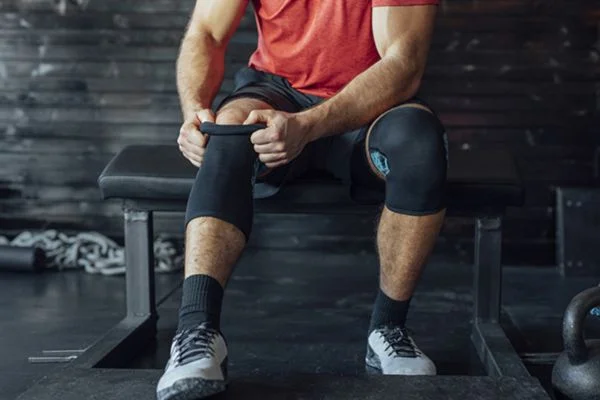Have you been experiencing pain and swelling in your knee? You could be dealing with bursitis, an inflammation of the bursa, a small sac with fluid that helps reduce tissue friction. And one possible treatment for knee bursitis is compression. Let’s find out Is Compression Good For Knee Bursitis?
Yes, Compression Good For Knee Bursitis. Compression can help alleviate knee bursitis symptoms by reducing swelling and providing support. However, consult a healthcare professional for personalized advice on its use and other treatment options.
How Compression Works on Knee Bursitis
Compression is a type of treatment involving wearing specialized clothing around the affected area to reduce inflammation and improve circulation.
This can help reduce swelling, pain, and discomfort and promote healing. Compression garments are designed to be tight-fitting but still allow you to move freely. They also provide support, which can help prevent further injury or strain on the joint.
Also Read: Does Physical Therapy Help Bursitis?
Is Compression Good For Knee Bursitis
Compression for knee bursitis can be a great way to soothe the joint, reduce swelling and minimize discomfort. However, it’s essential not to take it to extremes to avoid causing more harm than good.
Bracing and compression wraps effectively support the knee joint and reduce inflammation but should only be used for short periods. It’s best to use compression garments during activities known to irritate your knees or increase swelling.
If you’re feeling pain while doing activities, then take a break, apply cold packs and wrap your knees with some form of bracing or light elastic bandage to help provide relief. Ultimately, it’s essential to listen to your body and not overexert yourself when using compression treatments for knee bursitis.
Also Read: Can You Run With Knee Bursitis?
What Type of Compression Is Best?

Several options are available when choosing a type of compression garment for knee bursitis. Generally speaking, depending on their needs, a person is recommended to opt for either an open or closed patella design.
Open patella designs are great for people suffering from chronic knee pain as they provide additional support around the kneecap while allowing some range of motion.
On the other hand, closed patella designs provide more support and stability around the entire joint, which can benefit those with acute pain or injury.
Closed patella designs are typically recommended for acute pain or injury as they provide more stability around your knee joint than open patella designs do.
However, it’s important to note that regardless of your design, all compression garments should fit snugly but not too tight, as this could cause further discomfort or even injury if not worn properly.
Also Read: What Causes Knee Hyperextension In Gait?
Other Ways To Manage Knee Bursitis
In addition to wearing a compression garment, there are several other ways that you can manage your knee bursitis, such as:
1. Icing your knee regularly (for no longer than 20 minutes at a time).
2. Taking non-steroidal anti-inflammatory drugs (NSAIDs) such as ibuprofen or naproxen sodium.
3. Avoiding high-impact activities like running or jumping until your symptoms have subsided.
4. Using a cane or crutches if needed when walking long distances.
5. Performing simple stretching exercises throughout the day to help keep your joints limber and flexible.
The Benefits of Compression for Knee Bursitis
Compression can help reduce the inflammation and pain associated with knee bursitis. Compression helps by providing gentle pressure to the area, which reduces swelling and increases blood flow to help improve healing.
The increased blood flow allows more oxygen and nutrients to reach the area, which aids in recovery. Compression may also provide support to the joint, helping prevent further injury or strain to the area.
Compression can come in many forms—from sleeves or wraps to braces or taping methods. Your doctor may recommend one type of compression over another based on your needs and situation.
For example, if you decide to use a sleeve or wrap for your knee bursitis, be sure that it fits correctly; too tight can restrict circulation, while too loose may not provide enough support. It’s essential when using any compression device to fit correctly to get maximum benefits.
Also Read: Can You Run With Knee Bursitis?
When Should You Wear Compression?
In general, you should wear compression when engaging in activities that strain your joints, such as running or sports activities — significantly if those activities aggravate your symptoms of knee bursitis.
Additionally, wearing compression while at rest can help reduce inflammation and discomfort associated with this condition. However, remember that everyone is different; talk with your doctor about what works best for you.
Also Read: What Kind Of Knee Brace Do I Need For Bursitis?
Wrapping Up:
So, is compression good for knee bursitis? Well, a compression is an excellent option for treating knee bursitis because it provides support and comfort while reducing inflammation and increasing blood flow around the joint—without taking medication or undergoing surgery!
Just be sure to get fitted properly for whatever type of compression device you choose so that it’s comfortable and practical. Then, talk to your doctor about what will work best for you so you can start feeling better soon!

